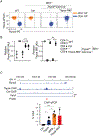NuRD complex recruitment to Thpok mediates CD4+ T cell lineage differentiation
- PMID: 35687698
- PMCID: PMC9484726
- DOI: 10.1126/sciimmunol.abn5917
NuRD complex recruitment to Thpok mediates CD4+ T cell lineage differentiation
Abstract
Although BTB-zinc finger (BTB-ZF) transcription factors control the differentiation of multiple hematopoietic and immune lineages, how they function is poorly understood. The BTB-ZF factor Thpok controls intrathymic CD4+ T cell development and the expression of most CD4+ and CD8+ lineage genes. Here, we identify the nucleosome remodeling and deacetylase (NuRD) complex as a critical Thpok cofactor. Using mass spectrometry and coimmunoprecipitation in primary T cells, we show that Thpok binds NuRD components independently of DNA association. We locate three amino acid residues within the Thpok BTB domain that are required for both NuRD binding and Thpok functions. Conversely, a chimeric protein merging the NuRD component Mta2 to a BTB-less version of Thpok supports CD4+ T cell development, indicating that NuRD recruitment recapitulates the functions of the Thpok BTB domain. We found that NuRD mediates Thpok repression of CD8+ lineage genes, including the transcription factor Runx3, but is dispensable for Cd4 expression. We show that these functions cannot be performed by the BTB domain of the Thpok-related factor Bcl6, which fails to bind NuRD. Thus, cofactor binding critically contributes to the functional specificity of BTB-ZF factors, which control the differentiation of most hematopoietic subsets.
Conflict of interest statement
Competing Interests Statement
The authors have no competing interests.
Figures








Comment in
-
Three residues in the BTB domain promote a good partnership between NuRD and Thpok.Sci Immunol. 2022 Jun 10;7(72):eabq1408. doi: 10.1126/sciimmunol.abq1408. Epub 2022 Jun 10. Sci Immunol. 2022. PMID: 35687694
References
-
- Ellmeier W, Taniuchi I, The role of BTB-zinc finger transcription factors during T cell development and in the regulation of T cell-mediated immunity. Current topics in microbiology and immunology 381, 21–49 (2014). - PubMed
-
- Kovalovsky D, Uche OU, Eladad S, Hobbs RM, Yi W, Alonzo E, Chua K, Eidson M, Kim HJ, Im JS, Pandolfi PP, Sant’Angelo DB, The BTB-zinc finger transcriptional regulator PLZF controls the development of invariant natural killer T cell effector functions. Nature immunology 9, 1055–1064 (2008). - PMC - PubMed
-
- Masuda T, Wang X, Maeda M, Canver MC, Sher F, Funnell AP, Fisher C, Suciu M, Martyn GE, Norton LJ, Zhu C, Kurita R, Nakamura Y, Xu J, Higgs DR, Crossley M, Bauer DE, Orkin SH, Kharchenko PV, Maeda T, Transcription factors LRF and BCL11A independently repress expression of fetal hemoglobin. Science 351, 285–289 (2016). - PMC - PubMed
Publication types
MeSH terms
Substances
Grants and funding
LinkOut - more resources
Full Text Sources
Molecular Biology Databases
Research Materials

